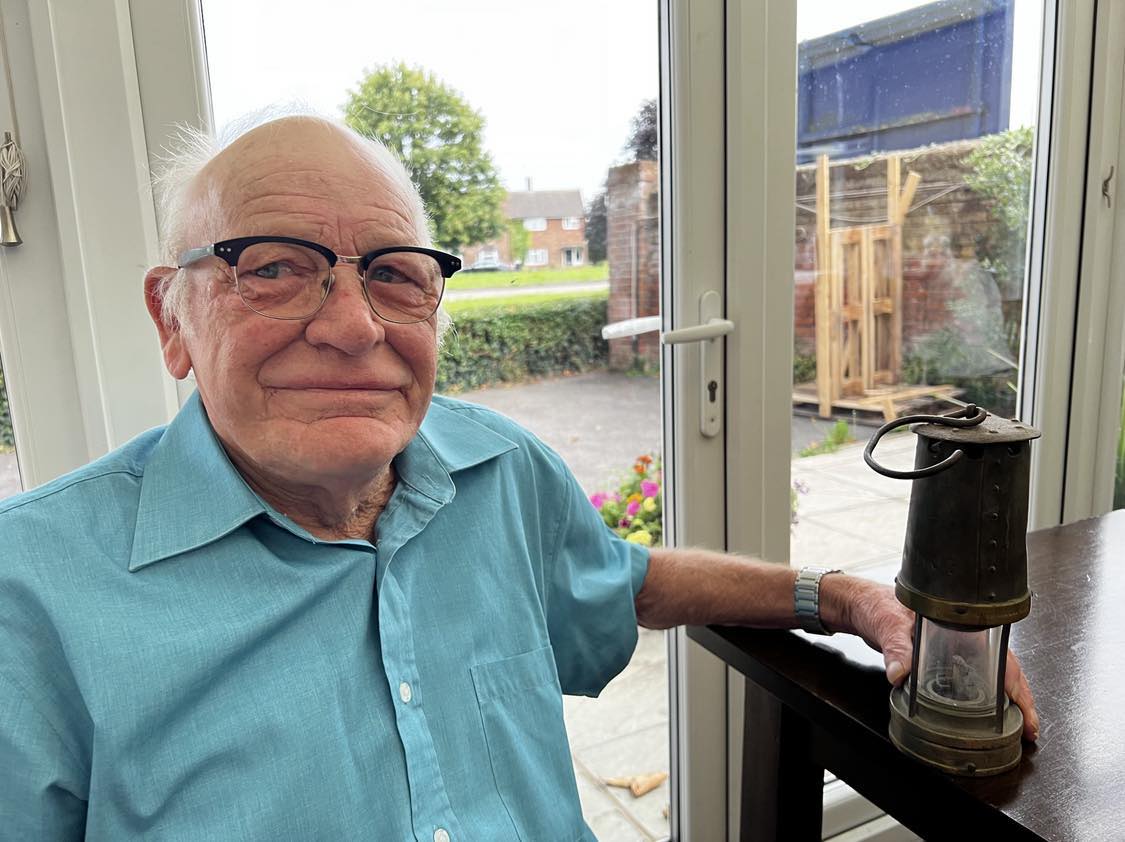
The venue for the informal evening was, once again, the Victoria Hotel in Canterbury.
It was Rotarian Brian Dobinson that had suggested inviting Roy to our meeting, and it was Brian that interviewed Roy in a conversational, Parkinson-like manner – asking probing questions and prompting Roy to tell us various facts and anecdotes about his life. The set up was such that audience members could ask any questions they wanted during the evening – and there certainly were lots of questions!
Roy, who is now 81, was asked by Brian to describe his early life before he became a miner. “Well, I was born in the slums of Canterbury” he started, moving on to describe how very basic his home was at that time – with an outside toilet and a hole in the roof. “In the winter not only was there 6 inches of snow outside, there was six inches of snow inside,” he said.
Although Roy’s father was in the army, his parents had split when he was just six years old, and his early years were full of hardship. His clothes were all donations via the WRVS (Women’s Royal Voluntary Service) – he recalls his plimsolls having a hole that was filled with a piece of cardboard.
Roy went to Saint John’s school in his primary years and then moved to Frank Hooker (now Canterbury Academy) for his secondary schooling. He recalls that his only meal used to be the free school dinner he was entitled to, and the milk that they were all given at school.
Prompted by Brian, Roy told us how he’d applied for a job to go down the coal mine at the mere age of 15. His application was accepted, but as he wasn’t allowed to work underground until he was 16, he spent a year training at Bettshanger Colliery. On reaching 16, Roy was finally allowed underground at Chislet Colliery – although he still had to spend his first 20 days working under supervision. His starting role was to switch on and off the huge coal conveyer belt that shifted the coal, and to keep the conveyor clean.
Asked by an audience member about National Service, Roy pointed out National Service had finished just before that time – although he added that working in coal mines was exempt anyway.
Roy went on to describe the difficult conditions under which he and his colleagues had to work. For example, the mines were “alive with mice.” Roy recalled hearing a sudden scream one day – a mouse had gone up the trouser leg of one of his colleagues! The mice used to find sandwiches wherever they were hidden, so the only way that the sandwiches could be taken into the mines was in a tin.
The major challenges for miners were the darkness, the heat, and the humidity. Miners could only see an arm’s length in front of them – even when their helmet lights were switched on. Conditions were incredibly hot – the natural temperature of the rocks at 60 feet below ground was around 50 degrees, and Roy told us how he would take an 8-pint bottle of water to drink down with him to help cool down. The high humidity and seeping water were a greater problem; Roy recalled taking his boots off, pouring out the water and wringing out his socks before putting them back on. Sometimes Roy would have to work in water up to his waist.
Roy had to do a further 100 – 120 days training before he was allowed to work on the coalface itself. He then did two years as a coalface labourer. His salary gradually increased as he gained experience until he reached full pay for a miner.
Days were long and hard for a miner. They would be taken to the site by Lehane’s (now more well known for their coaches). The day would start early, and it would take 15 mins to travel down from ground level in a “cage” into the mine. One audience member asked what it felt like to go down in the cage – Roy said there was a similar effect to going on a plane, “but one got used to it after a while”.
We learned that there was a tally system of small tokens that were used to know who was in or outside the mine at any time; a triangular token was worn from the belt and used “to identify bodies” in the event of a fire or explosion. This was Roy’s first allusion to the enormous danger faced by miners in those days.
Each man was assigned an area 8 metres by the height of the coal seam by 4 foot 6 and was expected to shovel an astonishing 15 to 20 tonnes of coal in one 8-hour shift. The payment they received for that was 3 pounds. They would have a 20-minute break each day during which they ate their sandwiches.
Roy was asked about canaries – of course. Yes, they did use canaries – but these were kept at the rescue station and only taken into the mines if there was fire or an explosion. Apparently canary respiratory systems are much faster than ours, meaning they collapse quickly if oxygen levels fall. It was a surprise and relief to learn that the canaries never died in this way – gas cylinders were used to revive them!
Asked about accidents, Roy told us of several terrible accidents he knew of. We learned that there is a plaque of all men killed in the mines at Hersden’s working men’s club. Roy worked in the days before mechanisation of mining but, tragically, mechanisation did not mean accident-free, and Roy also described some truly horrific accidents that happened following mechanisation.
Roy was asked what happened to the slag heaps that resulted from mining in Kent. It seems that following the shocking disaster in Aberfan in 1966 (when over 120 school children and their teachers were killed when a coal heap collapsed) the coal board, chaired at the time by Lord Robens, limited the height of slag heaps so they are less obvious.
During Roy’s talk we learned there are five types of coal – including anthracite and bituminous coal; the coal in Kent is bituminous. The coal seam in Kent forms a basin from Ramsgate to Canterbury to Dover. The Chislet mine was 1500 feet deep and fell on the outer side of this basin – Roy recalls hearing overhead trains at snack time.
We learned that the height of a coal seam varies enormously around the world. The average height of a coal seam in England is about four foot, in Japan 30 foot, and in Australia an astounding 900 foot! In Kent, Roy worked on seams that ranged from 15 inches to 13 foot deep.
Interestingly, one of the features of the Kent coal field Is that it is the only coal field that is completely buried. Coal was only found when digging for the Channel Tunnel.
“It takes 1 yard of peat to make just 1 inch of coal” – Roy told us during his talk. We were also horrified to lean that some coal – though not in Kent – was subject to spontaneous combustion. Roy told us how all mines have dust barriers – basically inert dust – which are used to dampen fires if there is an explosion.
Roy got married in 1964 – at the age of 22. Brian interjected to ask Roy how much weighed at the time. Roy told us he weighed just 7 stone then.
Roy’s wife was an industrial machinist who made Turkey’s saddles. Following expressions of disbelief from audience members, Roy pointed out that these are very much like horse saddles and were used on female turkeys as the males would dig their claws in! Interestingly, Roy’s wife also made curtains at the Gulbenkian.
Roy had met his wife at 17. As he’d had a hard upbringing, he had decided from a young age to save up for a house. Eventually, before he got married, he managed to buy a brand new bungalow at Broad Oak. Like many of our audience members, Roy recalled the mortgage rate shooting up in the 70s; for Roy this meant a repayment going from around 19 pounds to 90 pounds per month. To repay his mortgage and also maintain his family (then of four), Roy had to work seven days per week. Sometimes his shifts would start at 6:00 am and he would return home at 10:00 pm. “I’ve known times when I’ve gone two to three months without seeing daylight” he said.
Chislet mine closed in 1969, at which point Roy moved to the colliery in Snowdon. He studied mining for five years and then applied for a job at Bettshanger as a training instructor before returning to Snowdon. When he went back to Snowdon he said it was as if he’d never left – “the comradeship there was just brilliant”!
Asked why he had decided to go into training, Roy pointed out how he was always interested in young people. “I wanted them to be the best that they can be, and do the best that they can do,” he said.
Inevitably, there were questions about Arthur’s Scargill and the miners’ strike of the 1980s. “I went to a meeting with Arthur Scargill” said Roy, but Roy wasn’t in the National Union of Miners (NUM), which meant that his family had no support during the infamous strikes.
In 1989 all coal fields in Kent were shut as a result of Margaret Thatcher’s policies. At that point Roy was offered a job as a training officer in the Channel Tunnel – but instead Roy got a job at Canterbury Cathedral (doing conservation work on the stone), which is where he worked until he retired.
All-in-all, Roy’s talk was truly fascinating – it was quite clear that one could actually talk about coal mining for hours. Roy opened our eyes to the extreme hardships and risks that miners took, and the many, many challenges of coal mining in those days.
There was very warm applause for Roy at the end of his talk and he was thanked by Rosemary Doyle on behalf of us all.
Picture: Roy took a look at a “miner’s lamp” that one attendee has bought in – and pointed out how it was not the genuine article! Picture credit: Rotary Club of Canterbury.


